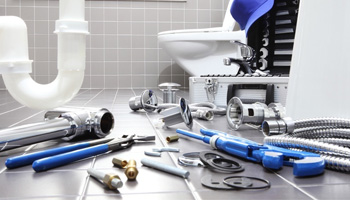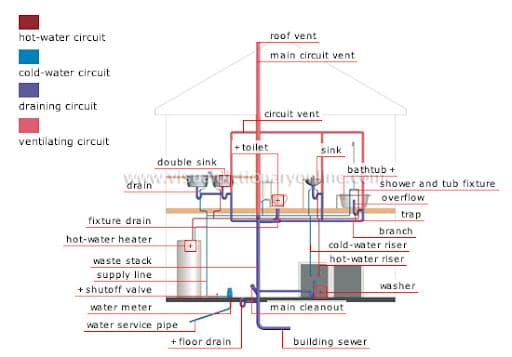Here underneath you'll find lots of good quality data on the subject of Exploring Your Homes Plumbing Anatomy.

Understanding exactly how your home's pipes system works is important for every house owner. From supplying clean water for alcohol consumption, food preparation, and bathing to safely getting rid of wastewater, a well-maintained plumbing system is vital for your family members's health and wellness and convenience. In this thorough guide, we'll explore the intricate network that comprises your home's pipes and deal tips on maintenance, upgrades, and managing common problems.
Intro
Your home's pipes system is greater than simply a network of pipelines; it's a complex system that ensures you have access to tidy water and reliable wastewater elimination. Knowing its components and how they work together can aid you prevent costly repair work and guarantee everything runs smoothly.
Fundamental Parts of a Pipes System
Pipelines and Tubes
At the heart of your pipes system are the pipelines and tubes that lug water throughout your home. These can be made of different materials such as copper, PVC, or PEX, each with its advantages in terms of sturdiness and cost-effectiveness.
Components: Sinks, Toilets, Showers, and so on.
Components like sinks, commodes, showers, and bath tubs are where water is made use of in your house. Recognizing exactly how these fixtures link to the plumbing system assists in detecting troubles and intending upgrades.
Shutoffs and Shut-off Points
Valves control the flow of water in your plumbing system. Shut-off valves are essential during emergencies or when you need to make repair services, enabling you to separate parts of the system without interrupting water circulation to the entire home.
Supply Of Water System
Key Water Line
The major water line attaches your home to the metropolitan water or an exclusive well. It's where water enters your home and is distributed to various components.
Water Meter and Stress Regulatory Authority
The water meter procedures your water usage, while a pressure regulator guarantees that water flows at a secure stress throughout your home's plumbing system, preventing damage to pipelines and components.
Cold Water vs. Hot Water Lines
Understanding the distinction between cold water lines, which provide water straight from the primary, and hot water lines, which lug warmed water from the water heater, aids in troubleshooting and planning for upgrades.
Water drainage System
Drain Pipeline and Traps
Drain pipelines lug wastewater away from sinks, showers, and toilets to the sewage system or sewage-disposal tank. Traps prevent sewage system gases from entering your home and likewise trap particles that could create clogs.
Air flow Pipes
Ventilation pipelines enable air right into the drainage system, protecting against suction that might slow water drainage and trigger traps to vacant. Appropriate air flow is necessary for preserving the stability of your plumbing system.
Relevance of Appropriate Drainage
Making sure proper water drainage avoids back-ups and water damage. Routinely cleansing drains pipes and maintaining traps can prevent pricey fixings and prolong the life of your plumbing system.
Water Heater
Sorts Of Hot Water Heater
Hot water heater can be tankless or standard tank-style. Tankless heating units warm water on demand, while containers store warmed water for immediate use.
Just How Water Heaters Connect to the Pipes System
Understanding how water heaters attach to both the cold water supply and hot water circulation lines aids in identifying problems like not enough hot water or leakages.
Upkeep Tips for Water Heaters
On a regular basis purging your water heater to remove sediment, examining the temperature settings, and examining for leaks can prolong its life-span and improve power performance.
Common Plumbing Concerns
Leaks and Their Causes
Leakages can happen due to maturing pipes, loose installations, or high water stress. Resolving leakages immediately stops water damage and mold and mildew development.
Clogs and Obstructions
Blockages in drains pipes and toilets are typically triggered by flushing non-flushable items or a build-up of oil and hair. Using drain screens and bearing in mind what drops your drains can protect against obstructions.
Indications of Plumbing Troubles to Expect
Low water pressure, slow-moving drains, foul odors, or unusually high water costs are indicators of potential plumbing problems that ought to be addressed promptly.
Plumbing Maintenance Tips
Routine Assessments and Checks
Arrange yearly pipes examinations to capture concerns early. Seek indications of leakages, rust, or mineral accumulation in taps and showerheads.
Do It Yourself Upkeep Tasks
Easy tasks like cleansing tap aerators, looking for commode leakages making use of color tablet computers, or protecting subjected pipelines in cool environments can avoid major pipes concerns.
When to Call an Expert Plumber
Know when a pipes problem requires specialist experience. Trying complex repairs without correct understanding can result in even more damages and higher repair prices.
Upgrading Your Plumbing System
Factors for Upgrading
Updating to water-efficient components or replacing old pipelines can enhance water quality, minimize water bills, and raise the value of your home.
Modern Pipes Technologies and Their Benefits
Explore modern technologies like wise leak detectors, water-saving bathrooms, and energy-efficient water heaters that can conserve money and lower ecological impact.
Expense Considerations and ROI
Compute the upfront prices versus long-lasting financial savings when thinking about pipes upgrades. Many upgrades spend for themselves through minimized utility expenses and fewer repair services.
Ecological Effect and Preservation
Water-Saving Fixtures and Devices
Setting up low-flow taps, showerheads, and commodes can considerably decrease water use without giving up performance.
Tips for Lowering Water Usage
Basic habits like repairing leakages without delay, taking shorter showers, and running full tons of laundry and meals can save water and reduced your utility expenses.
Eco-Friendly Pipes Options
Consider sustainable plumbing products like bamboo for floor covering, which is durable and environmentally friendly, or recycled glass for counter tops.
Emergency situation Readiness
Actions to Take During a Plumbing Emergency situation
Know where your shut-off valves are located and how to shut off the water system in case of a ruptured pipeline or major leak.
Relevance of Having Emergency Calls Useful
Maintain contact info for regional plumbing professionals or emergency situation services readily available for quick reaction throughout a pipes dilemma.
Do It Yourself Emergency Situation Fixes (When Appropriate).
Momentary fixes like utilizing air duct tape to spot a leaking pipeline or placing a container under a trickling faucet can reduce damage till a professional plumbing technician gets here.
Conclusion.
Understanding the anatomy of your home's plumbing system equips you to keep it effectively, saving time and money on fixings. By adhering to normal upkeep routines and staying notified regarding contemporary pipes modern technologies, you can ensure your pipes system runs efficiently for years to find.
HOW YOUR PLUMBING SYSTEM WORKS
Which Pipes Do What?
- Blue lines = fresh water supply entering the building
- Red lines = hot water supply entering the building
- Grey lines = pipes carrying waste away from the building and venting pipes carrying gases away from the building (through the roof)
YOUR MAIN PLUMBING SYSTEMS
There are two main plumbing systems that support your home s basic plumbing needs one that brings clean water into your home, and one that sends dirty water away from your home. Connected to the toilet, bath, shower, and other faucets in your home, these two systems keep your water flowing in the right directions.
ACCESSING FRESH WATER
Fresh and clean water is brought into your home through the main water supply line . Filtered through one pipe, this water is pressured to flow into the various fixtures in your home at any given time.
This water can be sourced from a well located on your property, a pond or river (mostly cottages), or, as in most cases, from the city s municipal water treatment centre. However, it is important to note that water that is untreated, such as the water siphoned from ponds or rivers, may not be safe to drink. Personal water supplies always need to be treated for hardness and contaminants before consumed.
MUNICIPAL WATER SUPPLIES
- Improve taste and odour
- Remove sediment
- Eliminate hardness
- Reduce chlorine
COLD WATER SUPPLY VS. HOT WATER SUPPLY
Cold water flows into your home or building through the service line, which then distributes hot or cold water to your fixtures. This line is most commonly run through a central column that runs floor to floor. Hot water runs in short and straight pipes as the longer the pipeline, the more heat that will be lost in the transfer. Having shorter pipes also allows residents to access hot water more quickly.
WASTE WATER SYSTEM
Your wastewater system is divided into two parts pipes that send wastewater away from your home and venting pipes that send sewer gas away from your home. Sewage water travels through pipes that flush the water and waste towards local sewers that are operated and managed by your city or town. Most sewer systems rely on gravity to move the wastewater to where it needs to go.
The further away from your toilet or sink, the larger wastewater pipes become. This allows for waste to be disposed of from various parts of your home or business at once without pipe blockages. The angle and flow of these pipes are also essential for keeping your waste pipes clear of build up.
https://harrisplumbing.ca/how-your-home-plumbing-system-works/

I'm certainly very taken with Anatomy of a House: Understanding the Components and I am hoping you appreciated the entry. Are you aware of somebody else who is looking into the subject? Do not hesitate to promote it. Thanks a lot for taking the time to read it.
Call Today
Comments on “Essential Components of Your House's Plumbing System”